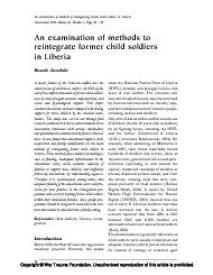An examination of methods to reintegrate former child soldiers in Liberia
A major feature of the Liberian conflict was the extensive use of children as soldiers. In 2003, by the end of the conflict, thousands of former child soldiers were in need of urgent economic empowerment, and social and psychological support. This paper examines the various methods employed inproviding support for these children by the relevant stakeholders. The study was carried out through field research, conducted in Liberia, which involved direct observation, interviews with various stakeholders and questionnaires administered to former child soldiers. It was found that educational support, skills acquisition and family reunification are the main methods of reintegrating former child soldiers in Liberia. These methods face a number of challenges, such as funding, inadequate infrastructure in the educational sector, weak economic capacity of families to support these children, and ineffective follow up mechanisms by implementing agencies. Therefore it is recommended, among others, that adequate funding of the educational sectors and provision for poor families in the reintegration programme will assist in keeping former child soldiers within their immediate families. Also, specific programmes should be designed to reach out to the children that cannot be absorbed into a family setting
Geachte bezoeker,
De informatie die u nu opvraagt, kan door psychotraumanet niet aan u worden getoond. Dit kan verschillende redenen hebben,
waarvan (bescherming van het) auteursrecht de meeste voorkomende is. Wanneer het mogelijk is om u door te verwijzen naar de bron
van deze informatie, dan ziet u hier onder een link naar die plek.
Als er geen link staat, kunt u contact opnemen met de bibliotheek,
die u verder op weg kan helpen.
Met vriendelijke groet,
Het psychotraumanet-team.
Reference:
Bosede Awodola | 2012
In: Intervention: the international journal of mental health, psychosocial work and counselling in areas of armed conflict, ISSN 1571-8883 | 10 | 1 | 30-42
http://www.interventionjournal.com/sites/default/files/Awodola_2012_Intervention_10_1.pdf
In: Intervention: the international journal of mental health, psychosocial work and counselling in areas of armed conflict, ISSN 1571-8883 | 10 | 1 | 30-42
http://www.interventionjournal.com/sites/default/files/Awodola_2012_Intervention_10_1.pdf


